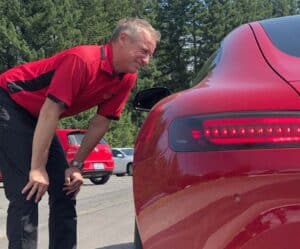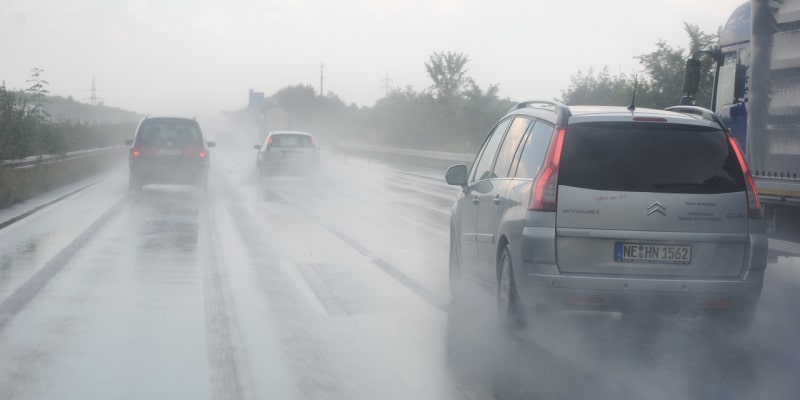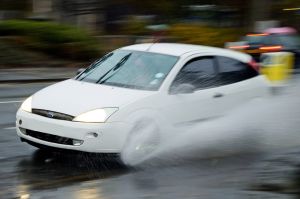ProFormance’s head coach reveals everything you need to stay safe on wet roads.
Now is a good time to recap the rules for safe winter driving, and The Inside Line is the place to do it: ProFormance Racing School’s chief instructor Don Kitch, Jr. literally wrote the book – really the essay – on driving in inclement weather. His summary of techniques entitled The Art of Racing in the Rain inspired a best-selling novel and a movie, but it also revealed how good drivers can make the most of every moment on the track during wet weather.
Those techniques are not confined to competition: “The same rules apply to anyone’s winter driving as it does to high performance sport driving or racing,” says Don. The essay is worth reading, but Don has provided a useful summary below.
Winter driving rules
Rule 1: 9 and 3 on the steering wheel. The standard hand position, which every ProFormance instructor drills into to every driver at the start of the One-Day High Performance Driving Experience, gives you the best car control. It is also the safest position in the event that the airbag deploys.
Rule 2: Eyes up. As with all other types of driving, keeping your eyes aimed high and down the road is essential. In the rain and snow, eyes-up driving buys you time. Wet roads diminish your car’s traction and braking capability, so it takes more time to stop. “With your vision aimed high,” Don says, “you can see situations evolving in front of you that may require a reduction in speed, so you can react sooner.”
Rule 3: Smoothness is paramount. “Just as in racing, driving in the rain, snow, or ice is a constant search for traction. You need to find traction and maintain it. One way we lose traction is to transfer weight suddenly.”
Skid, the main worry in winter conditions, is caused by a massive uncontrolled transfer of weight. What causes that weight transfer? Being abrupt with all the control inputs in the car: steering, brakes, and gas.
“Winter conditions are not a time to be abrupt,” says Don. “When you’re fighting to maintain traction you don’t want to be throwing your weight around.”
Don tells students to picture blown (hollowed out) eggshells on the pedals. Apply gas and brakes softly and smoothly enough to keep from cracking those eggshells.
Aquaplaning – the bane of winter driving
Every driver has encountered that moment when they approach some deep standing water with no way to avoid it. The result can often be aquaplaning, a loss of contact with the road caused by a thin sheet of water between tires and asphalt. It’s a frightening and dangerous condition, and one worth learning how to prevent.
How to avoid aquaplaning
Keep wheel straight. When you approach deep standing water, try keeping the wheels pointed straight as you go through. That will allow the tires’ tread blocks to do a better job channeling off water than they would with the wheels turned.
Steady throttle. Your first impulse might be to jump off the throttle, but don’t do it. “When you do that, the suspension unloads, and the car lifts.” That makes more space for water to get in under the tires. Instead, just push the car through the deep water on throttle, without accelerating or decelerating, and keeping those wheels pointed straight.
Lose the death grip. “Expect the steering wheel to twitch a little when you go through the deep water. Let it whip and come back to a neutral position. Don’t panic and put the steering wheel in a death grip.” If you do grasp it too tightly, you’ll experience a change in directional control when you hit drier asphalt. A light grip on the wheel is the way to go.
Tire care in winter
Some more hints to keep you in control:
Tire pressure. Avoid big swings in tire pressure during rainy months. Some drivers think a big, squishy footprint will mean more traction in the rain. Don’t do it. Lowering pressure closes up tread blocks. It also cups the tire, meaning the contact patch between tire and road becomes concave, instead of convex. That lets more water in. Don recommends not more than a one- or two-pound difference between winter and summer tire pressure.
Tread depth. All season tires are great for rainy weather. What’s most important is not the type of tire but the tread depth. Deeper treads do a better job channeling off water.
This winter, take some time to commit these rules to memory. You’ll be safer for it, and so will the drivers around you, when the sky opens up and the rain starts.







